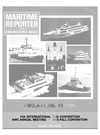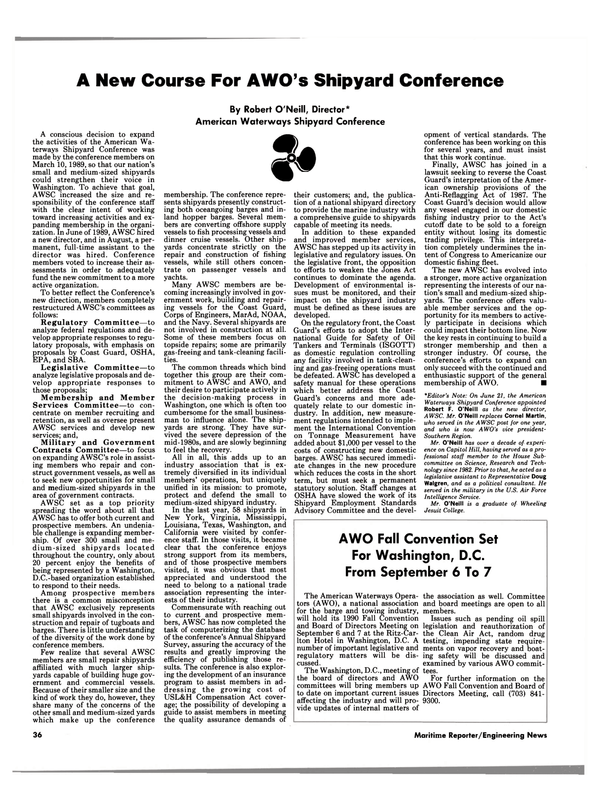
A New Course For AWO's Shipyard Conference
A conscious decision to expand the activities of the American Waterways Shipyard Conference was made by the conference members on March 10, 1989, so that our nation's small and medium-sized shipyards could strengthen their voice in Washington. To achieve that goal, AWSC increased the size and responsibility of the conference staff with the clear intent of working toward increasing activities and expanding membership in the organization.
In June of 1989, AWSC hired a new director, and in August, a permanent, full-time assistant to the director was hired. Conference members voted to increase their assessments in order to adequately fund the new commitment to a more active organization.
To better reflect the Conference's new direction, members completely restructured AWSC's committees as follows: Regulatory Committee—to analyze federal regulations and develop appropriate responses to regulatory proposals, with emphasis on proposals by Coast Guard, OSHA, EPA, and SBA.
Legislative Committee—to analyze legislative proposals and develop appropriate responses to those proposals; Membership and Member Services Committee—to concentrate on member recruiting and retention, as well as oversee present AWSC services and develop new services; and, Military and Government Contracts Committee—to focus on expanding AWSC's role in assisting members who repair and construct government vessels, as well as to seek new opportunities for small and medium-sized shipyards in the area of government contracts.
AWSC set as a top priority spreading the word about all that AWSC has to offer both current and prospective members. An undeniable challenge is expanding membership.
Of over 300 small and medium- sized shipyards located throughout the country, only about 20 percent enjoy the benefits of being represented by a Washington, D.C.-based organization established to respond to their needs.
Among prospective members there is a common misconception that AWSC exclusively represents small shipyards involved in the construction and repair of tugboats and barges. There is little understanding of the diversity of the work done by conference members.
Few realize that several AWSC members are small repair shipyards affiliated with much larger shipyards capable of building huge government and commercial vessels.
Because of their smaller size and the kind of work they do, however, they share many of the concerns of the other small and medium-sized yards which make up the conference membership. The conference represents shipyards presently constructing both oceangoing barges and inland hopper barges. Several members are converting offshore supply vessels to fish processing vessels and dinner cruise vessels. Other shipyards concentrate strictly on the repair and construction of fishing vessels, while still others concentrate on passenger vessels and yachts.
Many AWSC members are becoming increasingly involved in government work, building and repairing vessels for the Coast Guard, Corps of Engineers, MarAd, NOAA, and the Navy. Several shipyards are not involved in construction at all.
Some of these members focus on topside repairs; some are primarily gas-freeing and tank-cleaning facilities.
The common threads which bind together this group are their commitment to AWSC and AWO, and their desire to participate actively in the decision-making process in Washington, one which is often too cumbersome for the small businessman to influence alone. The shipyards are strong. They have survived the severe depression of the mid-1980s, and are slowly beginning to feel the recovery.
All in all, this adds up to an industry association that is extremely diversified in its individual members' operations, but uniquely unified in its mission: to promote, protect and defend the small to medium-sized shipyard industry.
In the last year, 58 shipyards in New York, Virginia, Mississippi, Louisiana, Texas, Washington, and California were visited by conference staff. In those visits, it became clear that the conference enjoys strong support from its members, and of those prospective members visited, it was obvious that most appreciated and understood the need to belong to a national trade association representing the interests of their industry.
Commensurate with reaching out to current and prospective members, AWSC has now completed the task of computerizing the database of the conference's Annual Shipyard Survey, assuring the accuracy of the results and greatly improving the efficiency of publishing those results.
The conference is also exploring the development of an insurance program to assist members in addressing the growing cost of USL&H Compensation Act coverage; the possibility of developing a guide to assist members in meeting the quality assurance demands of their customers; and, the publication of a national shipyard directory to provide the marine industry with a comprehensive guide to shipyards capable of meeting its needs.
In addition to these expanded and improved member services, AWSC has stepped up its activity in legislative and regulatory issues. On the legislative front, the opposition to efforts to weaken the Jones Act continues to dominate the agenda.
Development of environmental issues must be monitored, and their impact on the shipyard industry must be defined as these issues are developed.
On the regulatory front, the Coast Guard's efforts to adopt the International Guide for Safety of Oil Tankers and Terminals (ISGOTT) as domestic regulation controlling any facility involved in tank-cleaning and gas-freeing operations must be defeated. AWSC has developed a safety manual for these operations which better address the Coast Guard's concerns and more adequately relate to our domestic industry.
In addition, new measurement regulations intended to implement the International Convention on Tonnage Measurement have added about $1,000 per vessel to the costs of constructing new domestic barges. AWSC has secured immediate changes in the new procedure which reduces the costs in the short term, but must seek a permanent statutory solution. Staff changes at OSHA have slowed the work of its Shipyard Employment Standards Advisory Committee and the development of vertical standards. The conference has been working on this for several years, and must insist that this work continue.
Finally, AWSC has joined in a lawsuit seeking to reverse the Coast Guard's interpretation of the American ownership provisions of the Anti-Reflagging Act of 1987. The Coast Guard's decision would allow any vessel engaged in our domestic fishing industry prior to the Act's cutoff date to be sold to a foreign entity without losing its domestic trading privilege. This interpretation completely undermines the intent of Congress to Americanize our domestic fishing fleet.
The new AWSC has evolved into a stronger, more active organization representing the interests of our nation's small and medium-sized shipyards.
The conference offers valuable member services and the opportunity for its members to actively participate in decisions which could impact their bottom line. Now the key rests in continuing to build a stronger membership and then a stronger industry. Of course, the conference's efforts to expand can only succeed with the continued and enthusiastic support of the general membership of AWO. • *Editor's Note: On June 21, the American Waterways Shipyard Conference appointed Robert F. O'Neill as the new director, AtVSC. Mr. O'Neill replaces Cornel Martin.
who served in the AWSC post for one year, and who is now AWO's vice president- Southern Region.
Mr. O'Neill has over a decade of experience on Capitol Hill, having served as a professional staff member to the House Subcommittee on Science, Research and Technology since 1982. Prior to that, he acted as a legislative assistant to Representative Doug Walgren, and as a political consultant. He served in the military in the U.S. Air Force Intelligence Service.
Mr. O'Neill is a graduate of Wheeling Jesuit College.
Read A New Course For AWO's Shipyard Conference in Pdf, Flash or Html5 edition of August 1990 Maritime Reporter
Other stories from August 1990 issue
Content
- Largest Aluminum Charter Yacht In North America Delivered By Aluminum Boats page: 8
- Trinity Marine Group Licensed To Build Westamarin Aluminum Catamarans In United States page: 8
- Directions In Design Awarded Casino Boat Interior Design Contract page: 9
- Art Anderson Associates Expands Professional Staff page: 9
- Furuno Introduces New Shipboard Communications System page: 10
- Tidewater Adds 11 Boats To Domestic Fleet page: 10
- 'Reborn' Meridian Emerges From $55-Million Reconstruction At Lloyd Werft-Bremerhaven page: 11
- Cummins-Powered Aluminum Boat Delivered By Argo Marine For Logging Operation page: 12
- Service Marine To Build Dinner/Excursion Boat For Chicago Firm page: 12
- ASNE Symposium 1990 Set For Biloxi, Miss., September 27-29 page: 13
- Comsat Develops New High-Speed Data Service —Literature Available page: 13
- MSI Combines Emergency Medical Training Program With Shiphandling Course page: 14
- New Platinum Series Watermakers Introduced By Matrix Desalination page: 15
- ETA-Pilot Fuel Saving System Now Marketed Worldwide By SSPA page: 16
- New Designs And Developments From Munson Manufacturing In Oil Spill Response Vessels page: 18
- SeaArk Marine To Supply 19 Oil Spill Recovery Boats To State Of Florida page: 20
- Campbell Chain Develops New Process To Extend Chain Life page: 20
- IMO Double CIG Pumps Offer Increased Flow Rates At Lower Installed Cost page: 22
- Chantiers De L'Atlantique To Build Two Passenger Ships For Kloster Cruise page: 23
- Bird-Johnson Awarded MCM Propeller Contract page: 23
- National Waterway Conference To Hold Annual Meeting In New Orleans page: 24
- Do increased Tax Revenues' Translate Into Higher Waterways User Taxes? page: 25
- The Who's Who In NWC page: 25
- NWC: Promoting Sound & Far-Sighted Waterways Policies page: 26
- New Firefighting Foam Offered By Ansul For Flammable Liquid Fires page: 27
- Freeport Shipbuilding Begins Construction On Trend-Setting Carambat Megayacht/Houseboat page: 28
- Call For Papers Issued For 'Marine Computers '91' Symposium In Boston page: 29
- 11th International Tug Convention And International Marine Salvage Symposium page: 30
- ASSESSMENT OF THE U.S. MARINE MARKET page: 32
- Magellan Offers Low-Cost Portable GPS Receivers —Literature Available page: 33
- ASRY Dry Dock Occupancy Near 90 Percent During First Quarter page: 34
- Wartsila Diesel Announces Recent Personnel Appointments page: 34
- Coast Guard Announces Final Marine Vapor Control Regulations page: 35
- A New Course For AWO's Shipyard Conference page: 36
- Homeport Marine Delivers 'Eastern Wind/ First Of Two U.S.-Flag Fish Tenders page: 37
- NABRICO Delivers 260-Foot RO/RO Barges For Boston Harbor Project page: 37
- Furuno Introduces New FR/FAR-2800 Big Ship Radar/ARPA Line page: 40
- NuFlex Offers Composite Vapor Hoses For Transfer Operations page: 41
- Conferees A g r e e On Scheduling Of Tanker Double-Hull Phase-In page: 41
- New York Shipyard Reports Busy Vessel Repair Schedule page: 42
- $200-Million Japanese Liner Fitted With Magnavox Advanced Multi-Channel SatCom System page: 44
- Henschel Named Exclusive U.S. Licensee For Speed Measuring Units page: 45
- AMERICA'S SMALL- AND MEDIUM-SIZED YARDS REFERENCE GUIDE AND REVIEW page: 48
- Marine Gears Delivers Haley Units For Three Vessels At Main Iron page: 54
- COMSAT Acquires Interest In MMS page: 55
- ZF Announces Improvements In Four Marine Transmissions page: 56


